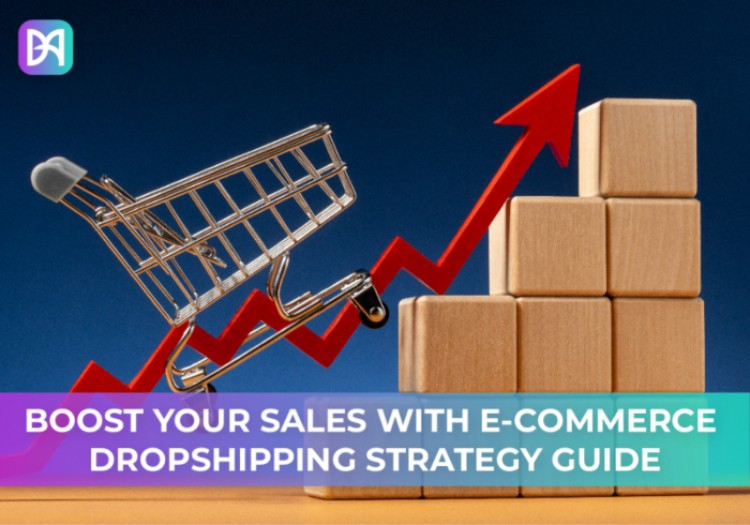Table of Contents
ToggleWhat is E-commerce Dropshipping?
E-commerce Dropshipping is a way of doing online business. It lets companies sell products without keeping them in stock.
Here’s how it works. When a customer orders, the company tells the manufacturer or distributor.
Then, the distributor sends the product straight to the customer. In this system, the drop shipper will do marketing.
Whereas, the manufacturer or distributor will manage shipping.
This method is good for new business owners.
Because they can sell products without the heavy cost. Big costing is caused by keeping and managing inventory. Learn to build a website to Sell Products with Digital Abouts.
Simple Steps to Start Your E-commerce Dropshipping Business
Remember this! E-commerce Dropshipping is an easy and successful company plan.
It offers a wide range of products without a need to keep inventory.
Starting a dropshipping business requires minimal investment.
This guide will help you get started. It will outline the important steps, tools, and key points.
Select a Business Idea

A detailed plan outlining the goods and target market is called a business idea. When starting a dropshipping business, it’s important to begin with a few products that cater to a specific demographic.
Let’s take an example. A graphic T-shirt business should focus on offering high-quality and stylish designs for customers.
The concept sets the foundation for the products, website design, and marketing strategies. It can be changed if necessary or if there is a shift in product interest.
Source Products
Before you create a website, it’s important to research products. This will allow you to find the best wholesale prices.
After finding good prices, choose products that will attract your audience.
Try to find many distributors who sell the same products.
Consider using print-on-demand services for items like clothing, home goods, or books. When selecting products, look for high profit margins.
The image quality should also be good. And it should have a good popularity in the market. Suppliers often provide statistics on what items are popular, which can help you choose products that are more likely to sell well.
Choose Providers
It’s time to choose a supplier to ship your products to customers.
Before making a choice, decide which items you want to offer.
Several factors should be studied while selecting a supplier:
- Remember to choose a supplier that fits your company’s focus on quality. Look for a supplier that prices their better products higher instead of lowering prices on lower-quality items.
Make sure to carefully choose the right supplier to establish your desired position.
- Dropshippers aim for profit margins of 15%-20%, factoring in shipping and transaction costs. While higher margins are acceptable, the ideal range is usually 15%-20%.
- When choosing a supplier, make sure they offer fast and affordable shipping and consistently have enough stock.
This will prevent customer dissatisfaction. The supplier should be located overseas and keep enough stock to avoid unfulfilled orders.
To check their reliability, consider placing a small order and monitoring the entire process.
- Make sure the supplier has a return policy, as many do not. Consider your return policies based on the supplier’s offer before making final decisions.
Dropshippers mostly use online markets. Because they have a wide range of products and honest suppliers.
Specific products can also be found from direct source suppliers. But this will need extra work and a limit of small monthly sales.
How to Build an E-commerce Website?

Here’s what you’ll need to Build an E-commerce Website:
- An electronic data management system, like Squarespace, Shopify, or WordPress
- Web hosting (Only if you use WordPress)
- A domain identity
- Partnerships with the drop shippers of your choice
- An integrated payment network to take payments remotely
Online stores like Shopify automate selling products.
This makes manual entry difficult and prone to mistakes.
For dropshipping businesses, Shopify is a popular choice. Yet, other platforms like Etsy, Amazon, and social media can also be helpful.
Selling through more than one channel can increase visibility and sales if done well. So, it’s smart for businesses with the capacity to consider these options.
Best E-commerce Platform for Small Business
When starting an online store, choosing the right E-commerce dropshipping platform is important to save time and effort.
Now is the perfect time for entrepreneurs and E-commerce enthusiasts to launch their venture. So, in this particular time, make sure to build a website to sell products. We have made a list of the best E-commerce platform for small business for you. It will help you create a successful website that looks good and runs well.
This will help them grow their business effectively.
An e-commerce platform is a program that enables companies to develop and handle online shops.
It enables the buying and selling of goods and services over the Internet.
The platform provides the following tools:
- Managing product catalogs
- Processing online payments
- Fulfilling orders
- Managing inventory
You can use the platform to market and manage your customer relationship.
Shopify is one of the best E-commerce platforms for small business. Others are:
- Wix
- BigCommerce
- AdobeCommerce
- WooCommerce
- Squarespace
- Big Cartel
- Square Online
- Shift4soft
What is E-commerce fulfillment & how to ship orders?
E-commerce Fulfillment involves tasks like receiving inventory, storing and packing products, shipping orders, and handling customer service and returns. Efficient and reliable fulfillment builds customer trust and brand loyalty, making the handling of E-commerce shipping crucial for business success.
Fulfillment is crucial in E-commerce, ensuring accurate delivery and processing of orders. However, poor fulfillment can damage customer trust, cause damage, and negatively impact sales and reputation.
Addressing inefficiencies and avoiding common errors can prevent delays, improve customer experience, and set businesses apart from competitors.
You can fulfill your orders in the following 5 steps:
- Receiving Inventory
- Inventory Storage
- Order Processing
- E-commerce Shipping
- Returns Processing




